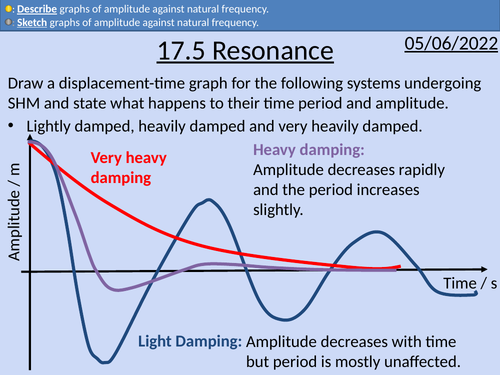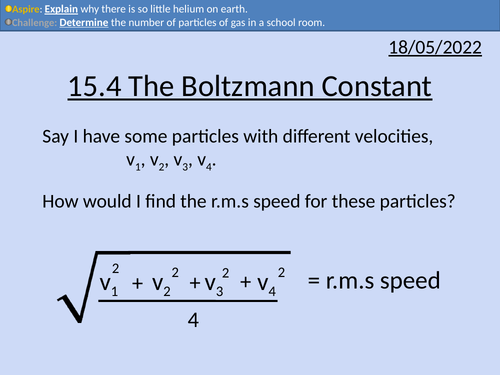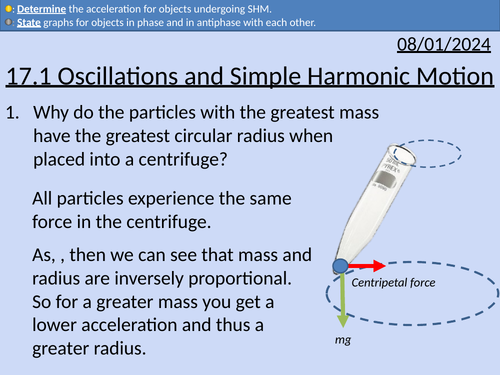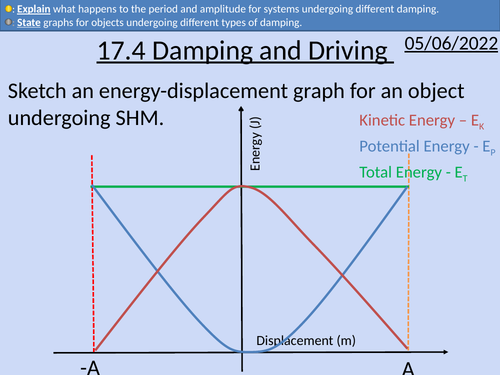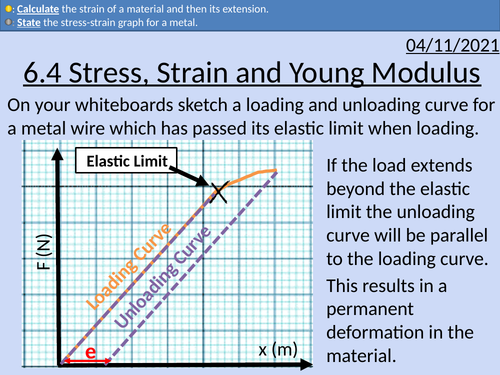497Uploads
168k+Views
72k+Downloads
Physics

OCR A Level Physics: Gravitational Fields
OCR A Level Physics: Gravitational Fields presentation, homework and answers.

OCR A Level Physics: The Boltzmann constant
OCR A Level Physics: The Boltzmann constant presentation with homework and answers

OCR A Level Physics: Analysing Simple Harmonic Motion
OCR A Level Physics: Analysing Simple Harmonic Motion presentation with homework and answers.

OCR A Level Physics: Simple Harmonic Motion and Oscillations
OCR A Level Physics: Simple Harmonic Motion and Oscillations presentation, homework and answers.

OCR A Level Physics: Damping and Driving
OCR A Level Physics: Damping and Driving presentation with homework and answers

OCR AS level Physics: Stress, Strain, &Young Modulus
OCR AS level Physics: Stress, Strain and Young Modulus is a part of the Module 3: Materials. Presentations come with worked examples, solutions and homeworks.

OCR A level Physics: The Nucleus
OCR A level Physics: 24.2 The Nucleus
Module 6 Particles and Medical Physics
This PowerPoint is a whole lesson included with student activities, animated answers, homework questions with answers provided.
This lesson covers:
Nucleons
Isotopes
Nuclear notation
Atomic mass units (u)
Radius for atomic nucleus equation
Volume and density of atomic nuclei
The strong nuclear force

OCR A level Physics: Half-life and Activity
OCR A level Physics: 25.3 Half-life and Activity
Module 6 Particles and Medical Physics
This PowerPoint is a whole lesson included with student activities, animated answers, homework questions with answers provided.
This lesson covers:
The reason why radioactive decays are considered random and spontaneous
Rolling dice being a good analogue for radioactive decays
Definition of half-life
Determining half-life from a graph.
Calculating half-life from a table of data.
Activity of a sample in Bq
The decay constant derivation

OCR A level Physics: Radioactive Dating
OCR A level Physics: 25.6 Radioactive Dating
Module 6 Particles and Medical Physics
This PowerPoint is a whole lesson included with student activities, animated answers, homework questions with answers provided.
This lesson covers:
State what isotopes of carbon are used in carbon dating.
Explain how carbon dating works.
Calculate the age of objects with carbon dating.

OCR A level Physics: Kinetic Theory of Gases
OCR A level Physics: Kinetic Theory of Gases is a part of the Module 5: Newtonian World and Astrophysics. The PowerPoint presentation includes worked examples, solutions and a homework.

OCR A level Physics: Radioactivity
OCR A level Physics: 25.1 Radioactivity
Module 6 Particles and Medical Physics
This PowerPoint is a whole lesson included with student activities, animated answers, homework questions with answers provided.
This lesson covers:
Types of ionising radiation (alpha, beta-plus/beta-minus, gamma)
Penetration power and ionising power
Detecting radiation with a Geiger (GM tube) counter
Background radiation and correct count rates
Electric and magnetic fields affect ionising radiation
Cloud chambers

OCR A level Physics: Nuclear decay equations
OCR A level Physics: 25.2 Nuclear decay equations
Module 6 Particles and Medical Physics
This PowerPoint is a whole lesson included with student activities, animated answers, homework questions with answers provided.
This lesson covers:
Typical speeds of radiation produced form nuclear decays
Conservation rules for nuclear decays
Nuclear notation
Alpha decays
Beta-minus and beat-plus decays
Gamma decays
Decay chains

OCR A level Physics: Modelling Radioactive Decay
OCR A level Physics: 25.5 Modelling Radioactive Decay
Module 6 Particles and Medical Physics
This PowerPoint is a whole lesson included with student activities, animated answers, homework questions with answers provided.
This lesson covers:
Iterative Method
Selecting appropriate time intervals
Comparing answers from the iterative method and exact solution.

OCR A level Physics: Quarks
OCR A level Physics: 24.4 Quarks
Module 6 Particles and Medical Physics
This PowerPoint is a whole lesson included with student activities, animated answers, homework questions with answers provided.
This lesson covers:
The Standard Model of particle physics
Quarks, anti-quarks and their charges
Baryons and mesons

OCR A level Physics: Antiparticles, Leptons, & Hadrons
OCR A level Physics: 24.3 Antiparticles, Leptons, & Hadrons
Module 6 Particles and Medical Physics
This PowerPoint is a whole lesson included with student activities, animated answers, homework questions with answers provided.
This lesson covers:
Antiparticles, their properties, and symbols
Particle and antiparticle annihilation
The four fundamental forces (strong nuclear, weak nuclear, electromagnetic, and gravitational forces) and their properties.
Definition and examples of hadrons and leptons.

OCR A level Physics: Binding Energy
OCR A level Physics: 26.2 Binding Energy
Module 6 Particles and Medical Physics
This PowerPoint is a whole lesson included with student activities, animated answers, homework questions with answers provided.
This lesson covers:
Definition of mass defect
Definition of binding energy
Binding energy per nucleon
Calculating mass defect, binding energy, and binding energy per nucleon.
Explaining nuclear stability

OCR A level Physics: Nuclear Fusion
OCR A level Physics: 26.4 Nuclear Fusion
Module 6 Particles and Medical Physics
This PowerPoint is a whole lesson included with student activities, animated answers, homework questions with answers provided.
This lesson covers:
Nuclear equations
Conditions for nuclear fusion
Binding energy and released energy

OCR A level Physics: Nuclear Fission
OCR A level Physics: 26.3 Nuclear Fission
Module 6 Particles and Medical Physics
This PowerPoint is a whole lesson included with student activities, animated answers, homework questions with answers provided.
This lesson covers:
Fuels in nuclear fission reactors
Moderators and thermal neutrons
Conservation of mass-energy
Energy released in fission reactions
Control rods
Nuclear waste management

OCR A level Physics: Einstein's Mass-Energy Equation
OCR A level Physics: 26.1 Einstein’s Mass-Energy Equation
Module 6 Particles and Medical Physics
This PowerPoint is a whole lesson included with student activities, animated answers, homework questions with answers provided.
This lesson covers:
Mass-energy is a conserved quantity
Einstein’s mass-energy equation
Particle and antiparticle annihilate each other
Rest mass and increasing mass with increased kinetic energy
Interpretation of mass-energy equivalence

